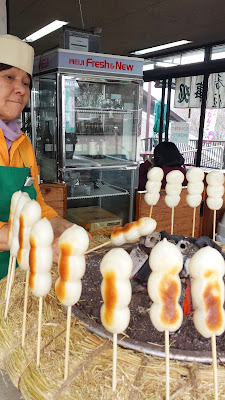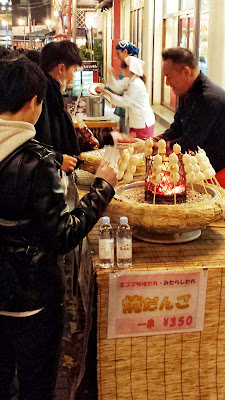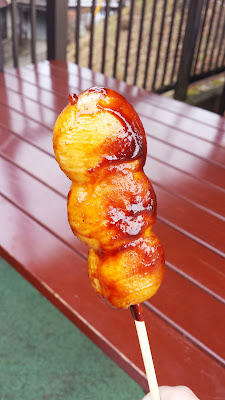I wanted to highlight some of the mysterious snacks and treats you may see when you are looking at food stalls nearby a temple or shrine. You won’t necessarily find all of these at a particular temple or shrine, but usually you will find some. This is not a full list- just my personal favorite Japanese Treats at Temples and Shrines.
The big motherlode is at Sensoji Temple in Asakusa, an area in Tokyo, because it boasts Nakamise Dori Shopping Street that almost everyone passes through from Kaminarimo
Dango
Dango is a doughy ball served on skewers. In most cases, the dango are each chewy like mochi usually brushed with a sweet sauce. They are usually slightly smaller than the size of a ping pong ball. There are multiple dango balls on a skewer. In some cases the dango are all the same, but there are also multi-colored pink white and green ball that may appear all on a stick too. I’ve also had a black one which was made with black sesame, a Mount Takao specialty.

In most cases the dango are also warmed slightly by a charcoal fire or grill so that parts of it are crisped up a little but on the outside on one side. It may be a modest fire like these


Or in the evening a little bit more dramatic with the flames.


They are usually plain when they are skewered by the fire, and then when you order a skewer, get the sauce brushed on and may get a quick extra warmed up closer to the heat for a few moments to glaze it slightly.

They are usually very chewy and have a napkin to wipe your face since the sauce may got on it!


There is one exception to this, which I have found on Nakamise at Sensoji. You’ll recognize this famous stand by the pink and bunny theme. Even though this is an exception, I always top and get it. Here, the dango are much smaller, more the size of marbles. This is Kibi-dango, a variation of dango made with millet flour. From this same stand you can enjoy with warm sake called Amazake that is very sweet and low alcohol. Here, I caught a few photos of the ladies rolling the kibi dango in the flour. Afterwards, since the flour is still a bit loose they serve the dango in a pink envelope with the white bunny logo on it. I highly recommend with Kibi dango to have it with a beverage as the flour coating instead of a sauce makes it more dry.
Ningyo Yaki
Ningyo Yaki is a cake filled with sweet red bean paste. You will often see it in the shape of various buildings or animals.
If you are lucky, you will see it being made fresh, either with an iron mold pan by hand, or by an automated machine!
By hand with a mold pan (at Sensoji Temple) – the man will first pour in the dough, add the bean, and then pour more dough on top and then place the mold on the small flames- he was super fast! You can see all the molds he is working with on the right as they are cooking to the right.:
Automated (at Himeji Castle):
At this particular machine (I won’t tell you how long I stood at the window, just fascinated each time I come across these…) there are two brushes on the right side of the machine that brush the inside of the molds – each mold’s side gets brushed. Then as it turns counterclockwise, the molds get dough squirted into it, then the sweet bean pellet is added. I couldn’t see all the way around so I’m not sure if then there is a second squirt of dough to cover the sweet bean before the mold is closed.
What I do know is then it clicks forward counterclockwise until the mold reaches a lever on the left side, around the 8 o’clock mark. Then, the lever flips the mold over to cook on the other side until around the 3 o’clock mark in the machine, a lever opens the mold and then a claw retrieves the hot now fully cooked cake.
Then, the claw drops it perfectly each time into a new smaller machine that times the cooling of the cake and then slides it into plastic to be individually wrapped.
Since these photos were taken by Himeji (a famous Japanese castle), no surprise that the ningyo yaki looks like a mini castle! When we purchased this, the man ran around the machine to give us a fresh, still warm one.
Manju
Manju is a batter (usually flour, rice powder and buckwheat) stuffed with some sort of filling (usually sweet red bean paste of boiled azuki beans and sugar). At Nakamise Dori, I was surprised to find more creative fillings, such as cherry, custard, pumpkin, sweet potato, green tea and more. Below, I got a Sesame Manju.
Nikuman
Nikuman is a smaller version of Chinese buns. They are steamed, and may be filled with meat or other fillings. They are served quite hot, often right out of the steamer, so definitely be carefully biting into it – the floury doughy soft bun may seem warm, but the inside can be piping hot.
You will probably recognize it by the wooden steamer trays stacked on top of each other
For instance, I found these in the Higashiyama District – we stopped for these buns because there is a beef and burdock one and also a bean and green tea vegetarian one!
Menchi Katsu
Menchi Katsu is a breaded and deep fried cutlet or croquette, usually meat but it could be another protein (in Kyoto we had the vegetarian options of potato or tofu skin).
This meat one below shown from near Sensoji Temple at the stand Asakusa Menchi (you will probably recognize it first by the line) is the best version I’ve ever had, famous for being particularly juicy / greasy depending on your point of view and they use a rare breed pork called Kouza-buta (Kouza pork) from Kanagawa.
I also found some while walking in Higashiyama shopping street towards Kiyomizudera Temple in Kyoto- they had filling options of Kobe beef, soy milk skin cream, and Japanese potato croquette.
Senbei
Senbei are Japanese rice crackers. There are a huge variety of senbei out there – some are sweet, salty, spicy, or savory, in all sorts of shapes and sizes and flavors. They are usually baked or grilled over charcoal. The mnst common ones you see are round, and may have a little square piece of seaweed wrapped around it and be shiny from a soy sauce glaze.
What has made senbei probably most famous is that they sell them to feed the deer at Nara. There is even a place where they throw large senbei like frisbee and the nburn down a mountain!?? Japan Talk has a webpage listing some interesting senbei trivia.
I admit I don’t necessarily seek out senbei because it makes me thirsty, and that makes me drink, and then I might have to use a public toilet and who knows if it will be the nice ones with buttons or a squat one (although at least unlike China they provide a nice handle on the wall to keep your balance). But I wanted to highlight an interesting one I found in Kyoto, on Higashiyama just across from the entrance to the Kodaji Temple. It was the aroma and seeing them being made fresh that caught my attention. Fresh senbei is always superior to packaged ones.
This one, according to a helpful English index card in the window, has been produced since 1864 and is still hand baked the exact same way. These are different in that they utilize broad bean, wheat, flour and an egg. The craftsman was super cheerful and welcoming even as he kept working the whole time. He uses those bags to pie in dough, but that rectangle in front of him is an oven full of broad beans that are being roasted – you an see some of the beans there on the cloth and paper in front of him. He scoops the beans from the big pot to his left and into drawers of the oven.
We sampled all the different kinds and the bag we bought did not make it out of Japan because we ate it all.
Amazake
Amazake is a sweet warmed sake. It is made out of fermented rice and Koji (a special cultured rice – it’s bringing the important fungus that will break down the carb of the rice to sugars) so the sweetness comes naturally, not from any sugar.
It is poured from the pot where it is still kept warm.
The texture is almost like an almond milk. There may be a lot or just a little of the rice left in the beverage.
It might be made out of white rice, brown rice, or even black sesame (which I found as a specialty at Mount Takao). It is low in alcohol, so even kids drink it. When it’s chilly out, it’s a nice warm drink that is more substantial than just tea.

Which of these treats caught your eye as something you would stop for? Have you had any of these before? Is there a Japanese Temple or Shrine snack I missed?
Here’s a summary of my Japan Travel post series:
- Guide to Planning a Trip: Research
- Guide to Planning a Trip: Mapping
- Hagoita Ichi Winter Festival at Sensoji Temple, Japan
- Japanese Treats at Temples and Shrines
- Winter Illuminations in Tokyo (Winter Season – November – February!)
- Snow Monkeys in Hot Springs
- Onsen by Mount Fuji covers Onsen 101 and how we loved our stay at Lake Kawaguchiko
- Dining at a Ryokan a look at what a traditional dinner and breakfast might be during a ryokan stay
- Visiting Cup Noodles Museum in Yokohama (just outside Tokyo)
- Visiting Shin Yokohama Ramen Museum
- Kyoto Temples and Shrines (walking tour starting in Higashimaya with stops especially at Kiyomizudera Temple, Kodaji Temple, Heian Shrine)
- Kyoto Temples in Arashiyama
- Kyoto Tofu
- Kyoto Famous Sights of the Kinkakuji (The Golden Pavilion) and Fushimi Inari (Red Torii Gates)
- Famous Signs of Osaka and eating Osaka Food specialities like okonomiyaki, takoyaki and kushikatsu
- Visiting Himeji Castle, the famous white castle in Japan
- Fun at Japanese Cafes and More including Maid Cafe, Cat Cafe; theme parks of J World and Namja Town, a geeky stop at Kanda Myojin, and Ghibli Museum
- Japan Eating Checklist is my top 25 list of things to try to include as an eating experience when visiting Japan
- New Year’s in Japan: Oji Fox Parade, and some photos of a Meiji Shrine visit on New Year’s Day








